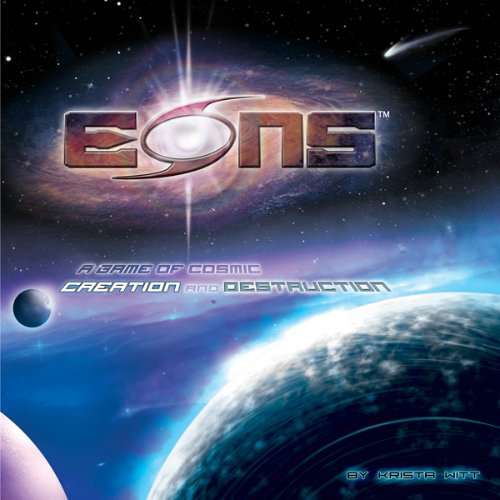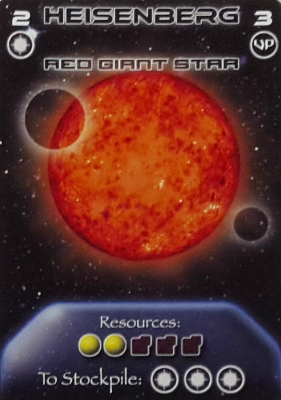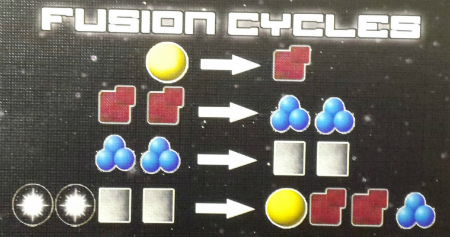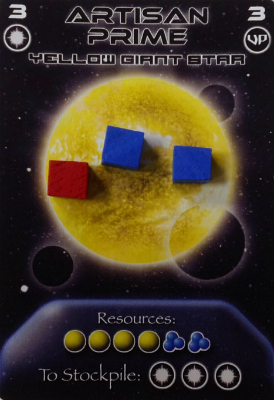Eons is based around the idea that players take on the role of Cosmic Architects. Beings of immense power and influence over the stars themselves, you are jotting about the universe guiding it along its path the best you can. In a way, these stars are like your children…whose temperature is a healthy 15 million degrees Celsius.
As it turns out, though, there are other Cosmic Architects out there too, and they’re looking to be doing the same. However, there’s only so much matter to make stars all those suns and planets. Competition ensues for these resources. Eons lets you play this scenario out as the universe continues to expand and grow more chaotic. You manage all those difficult decisions: which planet to build, how much carbon to stockpile, who should be on the receiving end of a supernova, and so on. Needless to say, controlling the universe can be a bit dizzying.
Luckily, the creators of Eons have decided to make it a bit simpler for us all by imparting some in-game wisdom. What follows is the official Eons Strategy Guide, written by the designers, complete with some strategic decisions to consider as you play.
Additionally, as the game continues to pick up new fans, variants to the game have started popping up either by fans or by the creators themselves. The largest category of these includes how to play Eons in Co-Op mode, wherein players are trying to beat various scenarios rather than one another. You can find the link to the Eons Co-op Guide at the bottom of this article.
 Eons is a resource management strategy game like no other, and offers avenues of competitive play that can leave even an experienced gamer spiraling towards entropy. We, the designers, have played a lot of games of Eons. We created this game with certain strategic methods in mind, and frankly, have discovered many others which players have gravitated towards after hours and hours of play.
Eons is a resource management strategy game like no other, and offers avenues of competitive play that can leave even an experienced gamer spiraling towards entropy. We, the designers, have played a lot of games of Eons. We created this game with certain strategic methods in mind, and frankly, have discovered many others which players have gravitated towards after hours and hours of play.
This short guide outlines three key strategic areas we’ve discovered in the competitive game, each with specific stratagems. It’s our hope that competitive players will use this strategy guide to reinforce things they’ve already discovered, introduce them to new play options they hadn’t considered, and increase the enjoyment of every game they play. Keep those stars burning!
Fusion is what Matters
The Fusion Cycle is perhaps the single most important area of the game of EONS. It provides avenues for players to enhance their power to create, and control the resource allocation for the entire game. The stratagems below are all about managing Fusion.
Three Moves Ahead
Those familiar with strategy games will usually understand this quickly, but when performing fusion on one of your stars and then harvesting the fused results off of it, you need to think about 3 Eons (turns) ahead, to determine what to leave on the star for future fusion and ensure your star doesn’t die from fusion death (unless this is planned strategy, of course). But we’ve found “3 Moves Ahead” to be about as deep as you should go. Why? Because the chaotic elements of the game (namely, the other players and their actions) can change your decisions quickly.
Leave No Trace
A common error for novice players is to leave element cubes on their stars that don’t need to be there. Fusion is the most efficient way to bring Carbon, Oxygen, and Iron into your Resource Pool. Early in the game (before a Resource Threshold has been established), there’s little benefit to using your stars to “hold” resources (unless you’re intentionally preventing them from re-entering the stockpile – a solid way to help execute the “Fusion Death” stratagem discussed below). Fuse as much as you can, and harvest it as soon as you can, while ensuring that you still leave enough on the star for future fusion.
Planned Obsolescence

Similar to “The Kamikaze Rogue” strategy, experienced players will create stars (usually low-cost stars) with the intent that they’ll only live a few eons. The player will reach a point where they’ll fuse, then harvest the entirety of the elements on the star.
Why? First and foremost, it moves the Entropy counter and the game towards completion. This can force the premature end of a game to the detriment of your opponents. Second, it’s a surefire way to get yourself Uranium, which is essential for some of the best cards in the game, and a guaranteed way to play a supernova – even when you’re tapped out on Essence.
A sub-variant of the “Planned Obsolescence” stratagem is “The One Cube Sink” – where the player leaves a single high-cost element cube on a star (usually Oxygen or Iron) and then spends 2 Essence to Supernova that star, granting them that single cube for their Resource Pool AND a Uranium – all for a cost of only 2 Essence.
When the Stars Wink Out

The Fusion Cycle is perhaps the single most important area of the game of EONS. It provides avenues for players to enhance their power to create, and control the resource allocation for the entire game. The stratagems below are all about managing Fusion.
The Rogue Shot
With a few exceptions, planets are harder to bring into play than stars, but offer greater rewards. The kicker is that planets must orbit a star in order to earn VP and Essence. When you take out a star, your goal should be to force your opponent into having multiple rogue planets that don’t earn them anything – forcing them to rely on their Focus Token to keep just a single rogue planet thriving.
If you wait to strike with a Supernova until a player has just spent a good deal of resources to bring orbiting planets into play, then your opponent is now short in their Resource Pool, and not gaining the benefits (Essence and VP) of those planets. True, they’ll most likely bring another star into play to support those planets, but those are several Eons where your opponent is playing catch-up.
The Kamikaze Rogue
In a game where the most advantageous phases of the Eon have the player who is doing the worst going first, sometimes it’s good to be in last place – and a savvy player can temporarily put themselves there without sacrificing their lead.
To accomplish this, a player with a massive star and several orbiting planets can build up a hand with a supernova and a replacement star, as well as the resource pool to put that star into play on the very next Create phase, and a good amount of Essence (usually 15 or more). The players can then intentionally supernova their own star at the end of the current Create phase. Why?
To put them (temporarily) dead last in VP count during the following Account phase, ensuring that they act first during Fusion and Purchase. Using their stockpiled Essence, the player can then deny other players key resources by getting to them first. When the next Create phase rolls around, they create their replacement star, focus it, and reap the benefits.
Controlling the Resource Stockpile
The most subtle of strategies in Eons is expanding your play to the point where you’re not just controlling your own Resource Pool and hand of cards – you’re controlling the entire Resource Stockpile, itself. This is not easy to do. Early in the game, most players don’t have the Essence or stars in play to affect the overall stockpile dramatically; and late in the game, the Resource Threshold brought on by ever increasing entropy makes resources hoarding an rather temporary proposition. But there are still stratagems a player can enact to influence the underlying economy of the game.
Forcing Fusion Death
 This is common component of advanced play strategy for very experienced players. Playing supernovae cards to destroy an opponent’s star is easy, but costs you 4 Essence (or precious Uranium).
This is common component of advanced play strategy for very experienced players. Playing supernovae cards to destroy an opponent’s star is easy, but costs you 4 Essence (or precious Uranium).
Experienced players will examine the needed fusion cycle progression for their opponents’ stars, and then work to empty the resource stockpile of those needed element cubes before that opponent can fuse. This requires you performing Fusion before they do (which means ensuring you are last in the VP count, perhaps with execution of “The Kamikaze Rogue” stratagem), and fusing with a goal of emptying the stockpile of specific elements your opponents need for their fusion cycles.
You can also elect not to fuse certain elements on your own stars, in order to keep them from re-entering the stockpile for an Eon or two.
The Carbon Crunch
Early in the game, Carbon tends to be the element that can quickly enter short supply in the stockpile. Not only is it needed to create the majority of stars and planets, but all stars start with Hydrogen, so a newly created star’s first Fusion phase will draw heavily on converting that Hydrogen to Carbon.
Early in the game, there’s usually no Resource Threshold limit, either. As such, savvy players will usually buy up as much Carbon as they can, and fuse every Hydrogen into Carbon on their stars early. A big mistake for rookie players is to “leave” Hydrogen un-fused on their stars. This puts you in “The Carbon Crunch” cross hairs early, as you may find yourself quickly unable to fuse. Focus on putting crucial Carbon into your Resource Pool, while keeping it out of the stockpile (and other players’ pools).
The folks at Gamer Nation Studios have made their guides into handy PDFs for download:
Download the Co-Op Instructions & Scenarios
